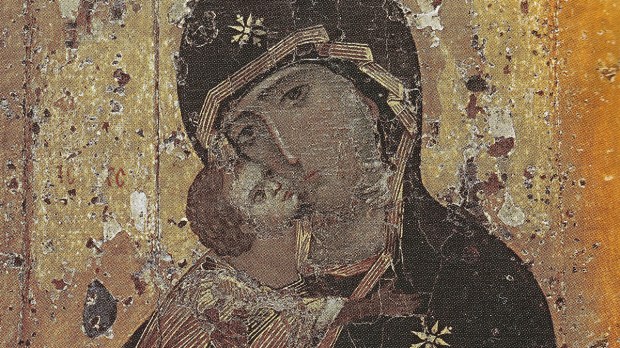I came across this article after a friend sent an email with something a priest had written about his having a holy card of the Virgin of Vladimir and had been praying more recently asking Mary to intercede and bring peace to the people and country of Ukraine. The Virgin of Vladimir is considered to be one of four icons attributed to St. Luke's artistry.
How the Virgin of Vladimir was originally from Ukraine

Public Domain
Philip Kosloski - published on 02/28/22
One of the most popular icons of the Virgin Mary, called the "Virgin of Vladimir," was originally a gift to the Grand Duke at Kyiv.
Many Catholics around the world are familiar with the “Virgin of Vladimir,” as it is an icon that is frequently used and bears a striking resemblance to the popular image of Our Lady of Perpetual Help.
One of the reasons behind its popularity is because it is said to be an icon written by St. Luke. Its history is nearly identical to many similar icons, tracing its origin to Constantinople.
An ancient tradition states that during the 5th century a Byzantine empress brought from Jerusalem to Constantinople an icon attributed to St. Luke. The Hodegon Monastery was built to enshrine it, and later all copies of this icon became known as Hodegetria. Most believe the original image was lost during the Middle Ages.
Virgin of Vyshgorod
The “Virgin of Vladimir” is from this same school of iconography, but was originally a gift to Kyiv.
Elaine Elizabeth Belz wrote the history of this icon in a paper for the graduate journal of the Harvard Divinity School.
Written in Constantinople around 1130, it seems to have been made as a gift from the Patriarch of Constantinople to the Russian Grand Duke at Kiev [Kyiv]. The date of the gift varies: Gasper-Hulvat places it between 1125-1131; Belting sets the date at 1136; while Skrobucha, working from the Russian Chronicles, is only willing to link the icon’s arrival at Kiev with the foundation of a church built there between 1131-1136.
At the time, it was enshrined in the Convent of Vyshgorod, near Kyiv.
Transfer to Vladimir and destruction of Kyiv
The image stayed there until Prince Andrei Bogolyubsky took the icon to Vladimir and established a new shrine there in 1160.
Afterwards, Bogolyubsky permitted his troops to sack and pillage Kyiv in 1169 and made his residence in Vladimir. This is briefly explained in the book A History of Russia.
Established as his father’s deputy at Vyshgorod, he takes French leave and goes off to Suzdal. When he himself could occupy Kiev, he entirely refused to move, putting deputies in his place and in 1169 his troops stormed the city, showing themselves utterly ruthless to man, woman, and child It was as if Kiev for him was a foreign town.
Afterwards, the Virgin of Vladimir became a national icon for Russia and has is currently housed in the Tretyakov Gallery in Moscow.
No comments:
Post a Comment